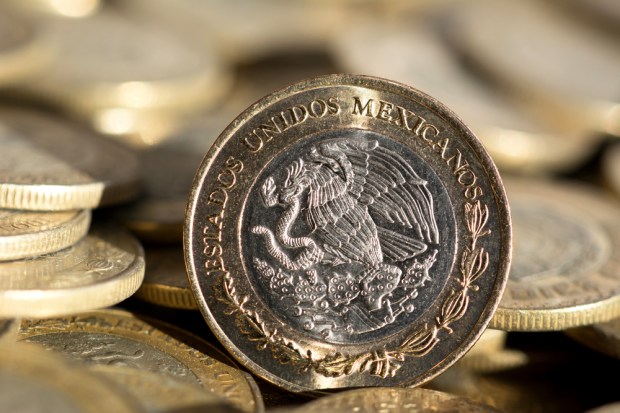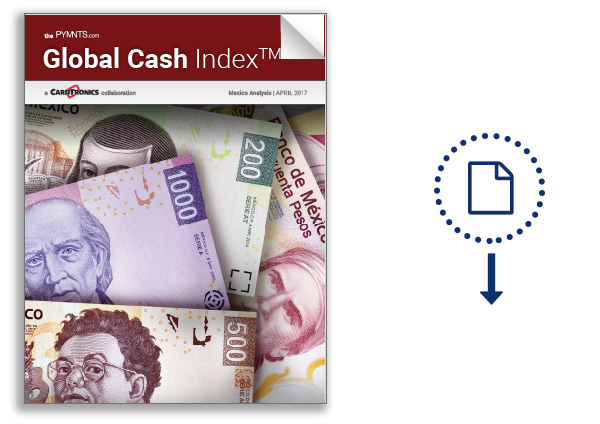Is Cash Having An E-Renaissance?

In June 2015, when eCommerce giant Amazon rolled out operations in Mexico, it entered a market where online shopping accounted for a mere 2 percent of the country’s $203 billion in retail sales, and the number of credit cards equaled a fifth of the country’s population of 120 million citizens.
For Amazon, finding success in Mexico meant adapting to market conditions, where credit and debit cards remain accessible to the working population in urban areas, but not so much in other parts of the country.
Almost six months after its launch, the company began selling gift cards at thousands of Oxxo convenience stores to tap into cash-paying consumers.
And Amazon isn’t alone. Linio, the largest eCommerce company in Latin America, now reportedly allows Mexican shoppers to pay by cash on delivery or at an Oxxo retail location.
Meanwhile, Walmart, the largest brick-and-mortar retailer in Mexico, has also found a way to woo online shoppers without access to credit cards by also enabling them to pay at physical store locations.
When it comes to payments, the common lesson these retailers have learned is this: In Mexico, cash is a way of life.
In the past 15 years, despite the rise of online banking and other forms of payment in Mexico, nearly 90 percent of consumer transactions are still paid using cash, according to research by Tufts University.
And to stay competitive, according to Javier Vallaure, chief business development officer at Allpago, the largest payment processing company in Latin America, international retailers are keeping cash payments front and center in expansion strategies to tap into Mexican consumers, many of whom often do not have access to credit or debit cards.
For these eTailers, bringing cash into the B2C payment equation has meant tapping into the vast network of convenience store locations spread across the country.
Cashing in on Convenience Stores
Shopping online and then running to a nearby convenience store to make payments in cash may be a concept unheard of in the U.S., but it’s commonplace in Mexico.
Much like Oxxo, 7-Eleven (which has over 1,800 stores in Mexico) and several other drug and convenience stores have become quick stop shops for Mexican consumers choosing to pay in cash for their online transactions.
While some of these consumers do not have access to credit and debit cards, many pick cash over cards for security reasons, Vallaure said.
To pay for online transactions in cash at one of the participating 14,000 convenience store locations, consumers check out with options such as “Pay at Oxxo,” which generates a bar code that can be scanned at the store to pay and complete the transaction.
Allpago, which powers cash-based payments for online merchants through Oxxo, reportedly sees 18 percent of online shoppers pay through convenience store locations and another 8 percent by cash on delivery.
Overall, when it comes to online payments, “credit and debit are the most used payment forms, but for B2C transactions, it’s paying through Oxxo,” Vallaure said.
While paying in person at Oxxo may be a go-to payment method for many online shoppers in Mexico, it’s also the one with higher checkout abandonment rate.
Only 30 to 40 percent of consumers who pick “Pay at Oxxo” actually end up going to the store to complete their transactions, Vallaure said, citing regretted impulse purchases as a primary reason.
And even though failing to capture impulse buyers checking out through “Pay at Oxxo” may seem like a pain point for eCommerce merchants, it doesn’t necessarily affect their bottom line.
In test mode, when the option to checkout with Oxxo is turned off, the volume of card-based transactions remains constant, which means cash-based payments through Oxxo, if anything, provide incremental value to merchants, Vallaure said.
“Shoppers that check out with Oxxo are people [who] couldn’t or wouldn’t pay with a card,” he said. “It’s either because they don’t have a bank account that they could use, the card is not working or they don’t trust the merchant at the moment.”
Informal Economy and the State of Cash
One of the biggest factors powering cash’s dominance in the Mexican economy is the significant presence of an untaxed informal economy, which has also contributed to a lack of financial inclusion.
A study published by the National Statistics Institute in December 2016 found that 58 percent of Mexico’s workforce is employed in informal sectors of the economy, including artisan and domestic work and unregistered vending.
While the Mexican government’s effort to channel payroll through debit cards has led to an explosion in overall card volume, most consumers continue to use their cards mainly for withdrawing cash from ATMs, Vallaure said.
In 2015, Mexicans withdrew a total of $176 billion from ATMs, a 41.82 percent increase since 2010, according to PYMNTS research.
However, slowly things are starting to change. With the growth of eCommerce, consumers are finally warming up to using debit cards for their online purchases, Vallaure said.
And even though debit and credit cards are projected to further increase their share in coming years, Vallaure believes the smart move for merchants is not to move away from facilitating cash-based payments, but to offer an array of payment methods to maximize outreach.
In the end, he believes that cash is anything but disappearing. “Not in the next five years, not even in the next 10 years. I don’t even see that in the near future in [the] U.S. or in Europe,” he said.
To download the analysis, please click below…
The PYMNTS.com Global Cash Index™, a Cardtronics collaboration, focuses on the use of cash for making payments and as a payment method that equally plays a role with cards, checks, direct debit and other methods of settling up between consumers and businesses. Unlike most reported estimates of cash, our proprietary data analysis focuses on the use of cash for making payments rather than hoarding.

